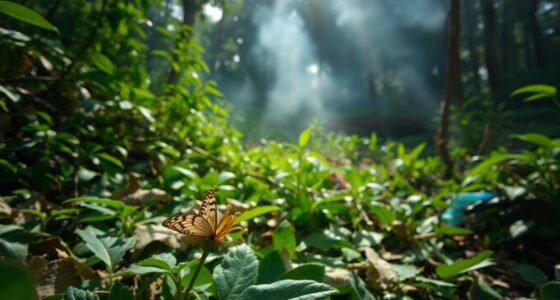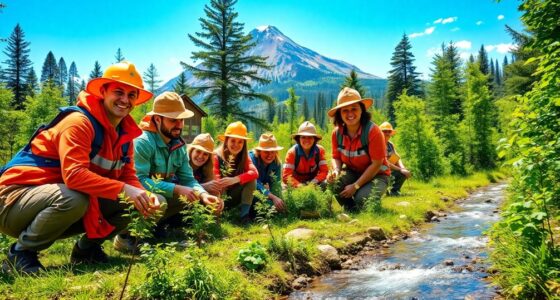As global temperatures rise, you might wonder how this affects the delicate balance of life on Earth. Climate change doesn’t just bring warmer weather; it drives habitat loss, disrupts migration, and makes species more vulnerable to threats. These changes threaten biodiversity at every level, pushing many species toward extinction. Understanding how human-induced warming accelerates these processes can help you see why protecting our planet’s ecosystems is more urgent than ever.
The Impact of Rising Temperatures on Ecosystems
Have you ever wondered how rising temperatures are transforming ecosystems? When temperatures climb, it disrupts the delicate balance of plant and animal life.
You might notice earlier springs, with flowers blooming sooner and animals emerging before usual. This shift affects breeding cycles, food availability, and migration patterns.
As some species struggle to adapt, others thrive in warmer conditions, altering predator-prey relationships.
Elevated heat levels can also lead to increased evaporation, reducing water sources essential for many organisms.
These changes create a ripple effect, forcing ecosystems to adapt quickly or face collapse.
The overall result is a loss of biodiversity and stability, making ecosystems more vulnerable to further stresses.
Rising temperatures fundamentally reshape the natural world you rely on, often with devastating consequences. Additionally, climate change accelerates habitat loss, further endangering countless species.
Habitat Loss and Fragmentation Driven by Climate Shifts
As climate shifts accelerate, many ecosystems face significant habitat loss and fragmentation, threatening the survival of countless species. Rising temperatures force plants and animals to move toward cooler areas, but human development and natural barriers often block these routes.
As habitats shrink and become isolated, species struggle to find food, mates, and suitable conditions. Fragmentation reduces genetic diversity, making populations more vulnerable to disease and extinction.
Coastal areas suffer from rising sea levels, flooding habitats and erasing critical breeding grounds. Forests may become fragmented by temperature-driven shifts in vegetation zones, leaving species confined to smaller patches.
This loss of continuous habitat disrupts ecological balance, putting additional stress on already vulnerable species and accelerating biodiversity decline. Additionally, habitat fragmentation can hinder species migration, impairing their ability to adapt to changing environmental conditions.
Disruption of Breeding and Migration Patterns
Climate change directly disrupts the timing and routes of animal migration and breeding, forcing species to adapt quickly to shifting conditions. You might notice birds arriving earlier or later than usual, or marine animals changing their breeding grounds. These timing shifts can cause mismatches with food availability, decreasing survival rates for young and adults alike. Migratory paths become more unpredictable as temperature gradients and weather patterns change, making navigation more difficult. As a result, animals may arrive at breeding sites too late or miss critical cues altogether. This disruption hampers reproductive success and reduces population stability. Additionally, the altered migration patterns can lead to increased energy expenditure and stress for wildlife, further threatening their survival. You may see species struggle to find suitable mates or environments, pushing them closer to extinction. Overall, altered migration and breeding patterns threaten the natural balance and resilience of ecosystems.
Increased Vulnerability to Pests, Diseases, and Invasive Species
Rising global temperatures and changing precipitation patterns weaken the defenses of many native species, making ecosystems more vulnerable to pests, diseases, and invasive organisms. As conditions become less predictable, pests thrive in warmer climates, reproducing faster and spreading more easily. The importance of color accuracy in visual systems underscores how subtle changes can have significant impacts on ecosystem health. Plants and animals stressed by climate shifts are less able to fight off infections or resist invasive species, which often outcompete native species for resources. You might notice pests like beetles or invasive plants spreading into new areas, disrupting local ecosystems. The increased vulnerability means that your local biodiversity faces heightened risks of decline and extinction. Without intervention, these invasive species and diseases could further destabilize ecosystems, reducing their resilience to future climate challenges.
The Role of Ocean Warming and Acidification in Marine Life Decline
Ocean warming and acidification, driven by increased greenhouse gas emissions, significantly threaten marine life. As sea temperatures rise, coral reefs and sensitive species struggle to survive, leading to widespread bleaching and death.
Warmer waters also alter migration patterns and disrupt breeding cycles for fish and other marine animals.
Acidification, caused by excess carbon dioxide dissolving into oceans, reduces the availability of calcium carbonate, essential for shell-building organisms like mollusks and plankton. This weakens their shells, making them more vulnerable to predators and environmental stresses.
These combined effects threaten entire ecosystems, diminish biodiversity, and jeopardize food sources for millions of people globally. Additionally, the decline of key species impacts marine biodiversity, which is crucial for maintaining healthy ocean ecosystems.
You must recognize that ocean health is intricately linked to climate stability and biodiversity conservation efforts.
Strategies for Mitigating Climate Change and Protecting Biodiversity
To effectively mitigate climate change and safeguard biodiversity, it’s essential to implement a combination of policy measures, technological innovations, and community-driven actions.
You can support policies that promote renewable energy, reduce emissions, and protect natural habitats.
Embracing clean energy technologies like solar, wind, and electric vehicles helps cut carbon footprints.
Engaging local communities in conservation projects ensures sustainable management of ecosystems.
You should also advocate for stricter protections for endangered species and restore degraded habitats.
Education plays a vital role, inspiring individuals to adopt eco-friendly lifestyles.
Collaboration between governments, scientists, and citizens accelerates impactful solutions.
Renewable energy sources are fundamental in reducing reliance on fossil fuels and decreasing greenhouse gas emissions.
Conclusion
By addressing climate change now, you can help protect biodiversity and prevent further extinctions. Reducing greenhouse gas emissions, supporting conservation efforts, and advocating for sustainable practices make a real difference. Every action counts in preserving ecosystems, safeguarding species, and maintaining the planet’s health. Together, you can play a vital role in fighting global warming and ensuring a thriving, resilient natural world for future generations.








